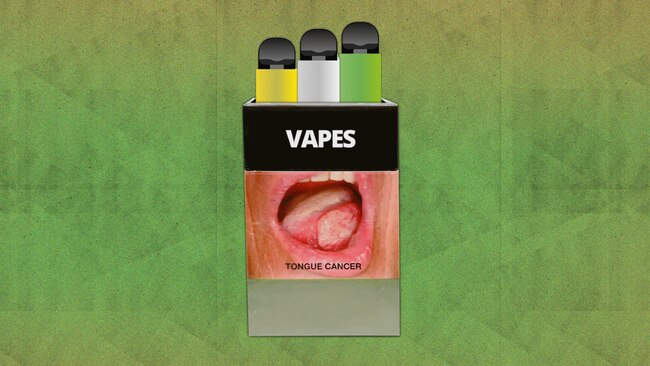Plain packaging laws for vapes may be introduced
“That is clearly marketing that's pitched to young children and very young adolescents.”

“That is clearly marketing that's pitched to young children and very young adolescents.”
The federal government will consider introducing plain packaging laws for vapes and e-cigarettes in a bid to curb rising use among young people and children amid a failing regulatory model that has fostered a thriving black market.
Federal Health Minister Mark Butler said proposed changes to vaping regulations included a crackdown on imports, introducing quality and safety standards and restricting labels and flavours to make e-cigarettes less appealing to children.
Mr Butler said vapes and e-cigarettes, which are often brightly coloured and sweetly flavoured, were clearly marketed at young people and that the Therapeutic Goods Administration would consider applying plain packaging laws to nicotine vaping products.
“I‘ve heard a very clear message from the public health sector, and from parents and school communities that these vapes that are marketed out there with pink unicorns, bubblegum flavours, fruit flavours – they are not being marketed to adults,” he said.
“That is clearly marketing that‘s pitched to young children and very young adolescents.”
Mr Butler left the door open to introducing a licensing scheme for vaping products and the introduction of a tobacco style excise, which a cost-benefit analysis has found could help the government raise more than $800m over four years through GST alone.
The health minister said the federal government would streamline existing state and territory regulations on tobacco and consider ways to reduce the appeal of smoking to young people, which could include making cigarettes unattractive colours and printing “smoking kills” on each stick.
Plain packaging laws have applied to cigarettes and tobacco in Australia for the past decade and are considered a landmark public health achievement.
On Wednesday the TGA released a consultation paper on proposed amendments to vape and e-cigarette regulations that said plain packaging could dissuade youths and nonsmokers from taking up vaping but warned the graphic warnings that feature on cigarette packs could deter people from using e-cigarettes as a quit smoking aid.
“For [nicotine vaping products] ‘plain packaging’ could mean packaging like other prescription-only medicines, with packaging in a monotone colour and labelling specifying the product name, nicotine content and Australian sponsor only,” said the paper.
The report suggested requiring the pre-approval of the names of vapes and e-cigarettes to ensure they did not appeal to children and adolescents.
Vapes containing nicotine can be easily purchased from tobacconists and convenience stores around Australia despite laws introduced by the former Coalition government in October 2021 that require customers to have a prescription.
Former smokers with prescriptions can also order vaping products, e-cigarettes and nicotine online under the personal importation scheme.
Australian Medical Association president Steve Robson said the personal importation of nicotine vaping products should be banned and he supported prohibiting sweet flavours and appealing packaging.
“The tobacco industry must not influence public health policy,” said Professor Robinson.
“It is heavily invested in e-cigarettes and has tried to hold back e-cigarette regulations.”
Earlier this month TGA chief John Skerritt told a senate estimates hearing that the current regulatory framework had failed to prevent children and young people from accessing vapes and e-cigarettes.
Australian Tobacco Harm Reduction Association founding chairman Colin Mendelsohn said the prescription model of regulation introduced last year had created the black market, which he said was now beyond regulation.
“They [TGA and government] are trying to patch up a model, which doesn’t work and will only get worse with further restrictions which is the problem that created it in the first place,” he said.
“They’ve created this black market and that’s what’s leading to kids vaping.”
Dr Mendelsohn said the only solution to the black market was to replace it with a regulated legal market.
A review by British policy institute Cochrane found rates of quitting smoking were higher when people used vapes and e-cigarettes than when they used nicotine replacement therapies such as patches.
Australian National University professor Emily Banks from the National Centre for Epidemiology and Population Health said a number of promising proposals had been put forward by the TGA and that vaping presented risks, such as developing a nicotine addiction, and benefits, such as aid to quit smoking.
“For people who are not smokers in the first place there’s no benefits and there’s quite a lot of risks,” said Professor Banks.
“Those risks are particularly bad for young people because their brains are still developing.”


